
Figure: Components of Graphical Modeler menu toolbar.
The Graphical Modeler is
a wxGUI component which allows the user to
create, edit, and manage complex models using easy-to-use
interface. When performing analytical operations in GRASS, the
operations are not isolated, but part of a chain of operations. Using
Graphical Modeler, that chain of processes (ie. GRASS modules)
can be wrapped into one process (ie. model). So it's easier to execute
the model later with slightly different inputs or parameters.
Models represent a programming technique used in GRASS GIS to
concatenate models together to accomplish a task. It is advantageous
when user see boxes and ovals that are connected by lines and
represent some tasks rather than seeing lines of coded text. Graphical
Modeler can be used as custom tool that automates a process. Created
model can simplify or shorten a task can be run many times and it can
also be shared with others. Important note is that models cannot
perform specified tasks that one cannot perform manually with GRASS
GIS. It is recommended to first do process manually, note the steps
(eg. using Copy button in module dialogs) and later duplicate them in
model.
The Graphical Modeler allows you to:
The main Graphical Modeler menu contains options which enable the user to fully control the model. Directly under the main menu one can find toolbar with buttons (see figure below). There are options like (1) Create new model, (2) Load model from file, (3) Save current model to file, (4) Export model to image, (5) Export model to Python script, (6) Add command (GRASS modul) to model, (7) Add data to model, (8) Manually define relation between data and commands, (9) Add loop/series to model, (10) Add comment to model, (11) Redraw model canvas, (12) Validate model, (13) Run model, (14) Manage model variables, (15) Model settings, (16) Show manual and last of them is button (17) Quit Graphical Modeler.

There is also lower menu bar in Graphical modeler dialog where one can manage model items, see commands, add or manage model variables, define default values and descriptions. Python editor dialog window allows seeing performation written in Python code. Rightmost tab of bottom menu is automatically triggered when model is activated and shows all the steps of running GRASS modeler modules. In case of some errors in calculation process, it is written at that place.
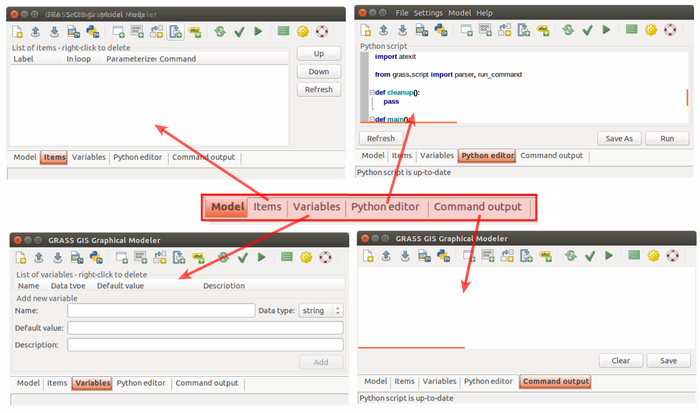










Another example:
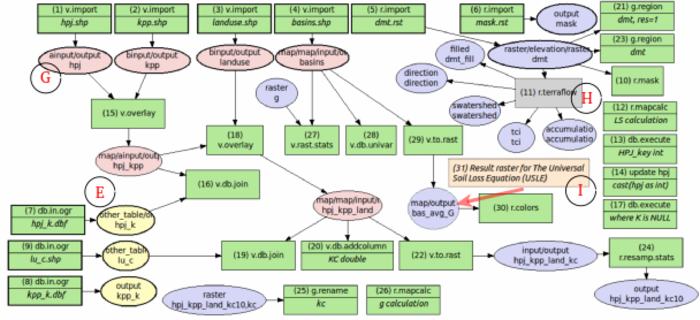
Example as part of landslide prediction process:
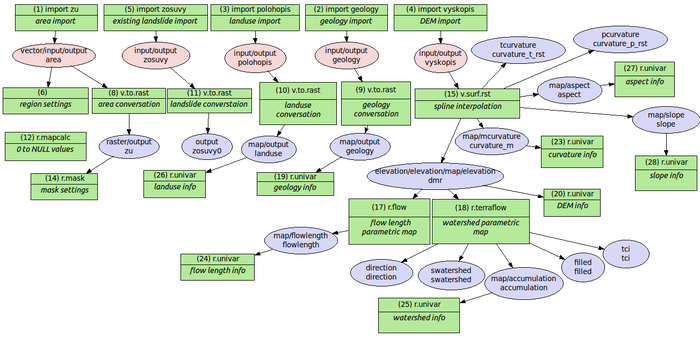
In command console it would be as follows:
# input data import r.import input=elev_state_500m.tif output=elevation v.import input=zipcodes_wake.shp output=zipcodes_wake # computation region settings g.region vector=zipcodes_wake # raster statistics (average values), upload to vector map table calculation v.rast.stats -c map=zipcodes_wake raster=elevation column_prefix=rst method=average # univariate statistics on selected table column for zipcode map calculation v.db.univar map=zipcodes_wake column=rst_average # conversation from vector to raster layer (due to result presentation) v.to.rast input=zipcodes_wake output=zipcodes_avg use=attr attribute_column=rst_average # display settings r.colors -e map=zipcodes_avg color=bgyr d.mon start=wx0 bgcolor=white d.barscale style=arrow_ends color=black bgcolor=white fontsize=10 d.rast map=zipcodes_avg bgcolor=white d.vect map=zipcodes_wake type=boundary color=black d.northarrow style=1a at=85.0,15.0 color=black fill_color=black width=0 fontsize=10 d.legend raster=zipcodes_avg lines=50 thin=5 labelnum=5 color=black fontsize=10
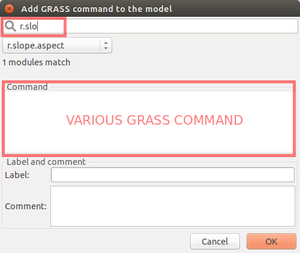
All of used modules can be parameterized in model. That causes launching dialog with input options for model after model is run. In this example input layers (zipcodes_wake vector data and elev_state_500m raster data) are parameterized. Parameterized elements have a little thicker boarder in model scheme with diagrams.
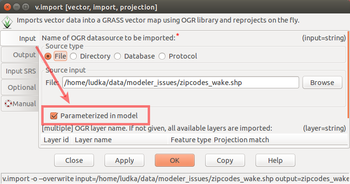
Final model, list of all model items, Python code window with Save and Run option are on figures below.


The resultant model for Graphical Modeler is available here.
After model is run with ![]() button
and inputs are set, results can be displayed as follows:
button
and inputs are set, results can be displayed as follows:

Very useful advantage is that for example, this model can later be used to calculate (let's say) average precipe value for every administrative region in Slovakia using precip raster data from Slovakia precipitation dataset and administration boundaries of Slovakia from Slovak Geoportal (only with a few clicks).
See also the wiki page (especially various video tutorials).
$Date$